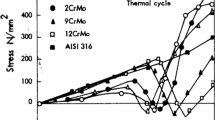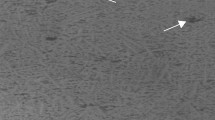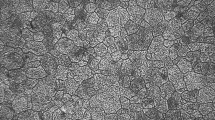Abstract
A computational approach based on the thermal elastic plastic finite element method was developed for predicting welding residual stress in low carbon alloyed steel welds by taking into account the effect of the solid-state phase transformations. The kinetics of phase transformations was described by Johnson Mehl Avrami Kolmogrov (JMAK) equation for bainitic transition and by Koistinen-Marburger (K-M) relationship for martensitic transition. Moreover, an additive rule depending on volumetric phase fraction was adopted to represent the material property changes during heating and cooling. Consequently, the residual welding stresses in a 2.25Cr1Mo steel TIG welded plate were computed. Early calculation results suggest that the bainitic and martensitic transformations took place in the weld the heat-affected zone drastically reduce the residual longitudinal tensile stress in the region.
Similar content being viewed by others
References
Handbook of residual stress and deformation of steel, ASM International, Ohio, USA, 2002, pp3–10.
D. Deng, Mater. Des. 30(2) (2009) 359.
T. Inoue and Z. Wang, Mater. Sci. Technol. 1 (1985) 845.
F.M.B. Fernandes, S. Denis and A. Simon, Mater. Sci. Technol. 1 (1985) 838.
B. Talijiat, B. Radhakrishnnan and T. Zacharia, Mater. Sci. Eng. A 246 (1998) 45.
D. Deng and H. Murakawa, Comput Mater. Sci. 37 (2006) 209.
S.H. Kang and Y.T. Im, Metall Mater. Trans. A 36 (2005) 2315.
S.H. Kang and Y.T. Im, Int. J. Mech. Sci. 49 (2007) 423.
H. Murakawa, I. Oda, S. Ito, H. Serizawa and J. Kansai, Soc. N. A., Japan, No. 243, 2005, pp.67–70.
H. Nishikawa, H. Serizawa and H. Murakawa, J Jpn Weld Soc 24(2) (2005) 168.
D. Radaj, Welding Residual Stresses and Distortion Calculation and Measurement-DVS, Düsseldorf, DVS, Verlag, 2003, 3-87155-791-9.
M. Fujita, J. Kinugawa, A. Okada and T. Kasugai, National Institute for Materials Science, Tokyo, Japan, 2003. http://inaba.nims.go.jp/weld/
G.J. Oliver, Fitting Parameters to Phase Transformation Kinetic Equations from CCT and TTT Diagram Data, Research Report, JWRI, Osaka University, 2002.
M. Lusk and H.J. Jou, Metall. Mater. Trans. A 28 (1997) 287.
G. Krauss, Principles of Heat Treatment of Steel, ASM International, Materials Park, Ohio, 1990, p.229.
D. Deng and H. Murakawa, Comput. Mater. Sci. 43 (2008) 681.
Author information
Authors and Affiliations
Corresponding author
Rights and permissions
About this article
Cite this article
Deng, D., Tong, Y., Ma, N. et al. Prediction of the residual welding stress in 2.25Cr-1Mo steel by taking into account the effect of the solid-state phase transformations. ACTA METALL SIN 26, 333–339 (2013). https://doi.org/10.1007/s40195-012-0163-8
Received:
Revised:
Published:
Issue Date:
DOI: https://doi.org/10.1007/s40195-012-0163-8




